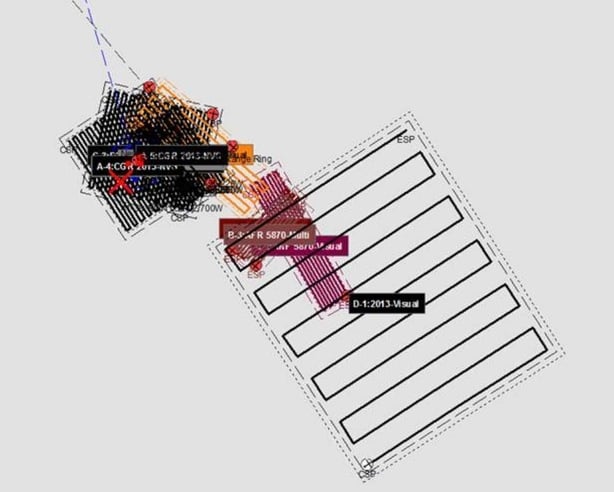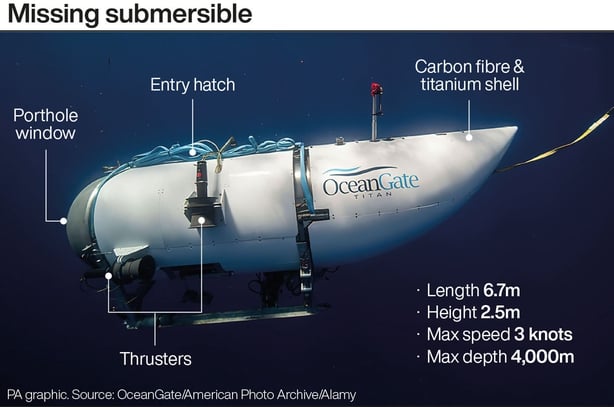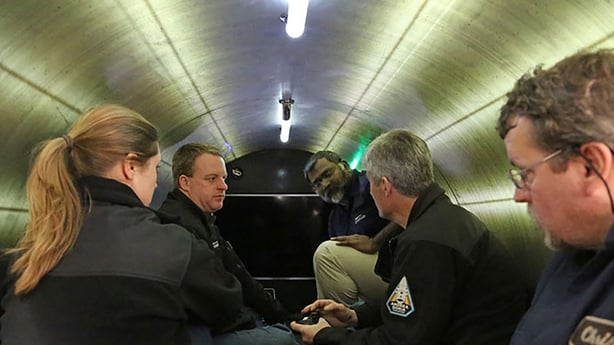The US Coast Guard has said that it had not identified the source of underwater noises detected by sonar in the search for a missing submersible near the wreck of the Titanic.
"We don't know what they are, to be frank with you," said Captain Jamie Frederick regarding the sounds that had raised hopes the five people onboard are still alive.
"We have to remain optimistic and hopeful when you're in a search and rescue case," he told reporters in Boston.
The Coast Guard said that searches are continuing, with teams working "tirelessly" in the ongoing search and rescue operation.
Officials have cautioned that the sounds may not have originated from the missing vessel.
Capt Frederick said that remotely operated vehicle (ROV) searches have so far yielded negative results, but they are continuing.
He said that the underwater noises were detected by Canadian Lockheed P-3 Orion aircraft yesterday, and that noise data sent to the navy overnight was still inconclusive.
The submersible vanished on Sunday during its descent to the century-old wreck of the Titanic.
The US Coast Guard said ROV searches were deployed in the area where Canadian aircraft detected the undersea noises using sonar buoys yesterday.
Estimates suggest the submersible's air supply could run out by tomorrow morning.
US Coast Guard Rear Admiral John Mauger told CBS earlier that two ROVs and a surface vessel are being used to try to locate the source of the noise.
"This is an incredibly complex site," he added, noting that metal and other objects under the water made it difficult to determine the source.
Even if the submersible is located, retrieving it presents huge logistical challenges, given the extreme conditions miles below the surface.
Teams from the United States, Canada, UK and France have searched more than 25,900sq/km of open sea.

The 6.7 metre submersible Titan, operated by US-based OceanGate Expeditions, began its descent at 8am (1pm Irish time) on Sunday, according to the US Coast Guard.
It lost contact with its parent surface vessel during what should have been a two-hour dive to the Titanic.
The US Coast Guard said yesterday evening that it had enough air left for 41 hours, based on its specifications, which would mean a deadline of roughly 6am (11am Irish time) tomorrow.
But experts say the air supply depends on a range of factors, including whether the submersible remains intact and still has power.
Read more
Man saved in deepest rescue off Irish coast 'frightened' for crew
The rescue armada racing to save missing sub
The wreck of the British ocean liner, which sank when it hit an iceberg on its maiden voyage in 1912, lies on the seabed at a depth of about 3,810m.
It is about 1,450km east of Cape Cod, Massachusetts, and 644km south of St. John's, Newfoundland.
Those on board the submersible, the highlight of a tourist expedition that costs $250,000 (€228,000) per person, included British billionaire and adventurer Hamish Harding, 58, and Pakistani-born businessman Shahzada Dawood, 48, with his 19-year-old son Suleman, who are both British citizens.
French explorer Paul-Henri Nargeolet, 77, and Stockton Rush, founder and chief executive of OceanGate Expeditions, were also reported to be on board.
A friend of Harding, Jannicke Mikkelsen, who has accompanied the British entrepreneur on other expeditions, said she was hoping for good news but was not optimistic.
"It would be a miracle if they are recovered alive," she added.

Questions about the safety of the Titan were raised in a 2018 legal action filed by OceanGate's former director of marine operations, David Lochridge, who claimed he was fired for voicing concerns that the hull could not withstand extreme depths.
In its own court claim against Mr Lochridge, OceanGate said he refused to accept the lead engineer's assurances and accused him of improperly sharing confidential information.
The two sides settled their court case in November 2018.
Neither the company nor Mr Lochridge's lawyer have commented on the details of the dispute.
Months prior to the action, a group of submersible industry leaders wrote to OceanGate warning that the "experimental" approach" to the sub's development could result in "minor to catastrophic" problems, the New York Times reported.
Aaron Newman, a former Titan passenger who knows some of the missing people, told NBC that he felt safe during his dive.
"Obviously, this is the type of exploration that's doing things - this is not a Disney ride," he said. "We're going places that very few people have been."
A French research ship carrying a deep-sea diving robot submersible was dispatched to the area at the request of the US Navy and was expected to arrive later today.
The unmanned robot is capable of diving as deep as the Titanic wreck and could help free the submersible if it is stuck, though the robot cannot lift the 9,525kg Titan on its own.

US Coast Guard said Canadian Lockheed P-3 Orion aircraft, which have sub-surface surveillance gear, detected the underwater noises yesterday.
Remote undersea equipment was deployed in the area and data from the aircraft was shared with US Navy experts "for further analysis which will be considered in future search plans," the US Coast Guard wrote on Twitter.
It did not give details about the nature of the sounds, but CNN and Rolling Stone magazine, citing internal US government communications, reported Canadian aircraft detected banging sounds at 30-minute intervals.
If Titan is stuck on the ocean floor, a rescue effort would require specialised equipment because of the massive pressures and total darkness at a depth of more than 3km.
Titanic expert Tim Matlin said it would be "almost impossible to effect a sub-to-sub rescue" on the seabed.
The sinking of the Titanic, which killed more than 1,500 people, has long been immortalised in books and films.
Popular interest was renewed by the 1997 blockbuster movie "Titanic".
Nargolet is 'very stable, very calm guy' - friend
Dr Joe MacInnis, a member of the first expedition to locate the wreck of the Titanic, described the situation as unimaginable and "a kind of mental nightmare".
He described the descent to the shipwreck as "like going to another planet".
He told RTÉ's News at One that one of his expeditions became snagged on the wreck of the Titanic.
Dr MacInnis said he knows one of the missing men, Paul-Henri Nargeolet, who he said "will be holding it together psychologically" on board the sub.
"He's a very stable, very calm guy ... the guy you would really want to have when this kind of thing is unfolding," Dr MacInnis added.
We need your consent to load this rte-player contentWe use rte-player to manage extra content that can set cookies on your device and collect data about your activity. Please review their details and accept them to load the content.Manage Preferences
Chris Reynolds, former director of the Irish Coast Guard, said the reports of underwater sounds "are the only encouraging thing" that he has heard in recent days.
Mr Reynolds, who has dived to the wreck of the Lusitania, told the same programme he accepted that rescuers "were looking at a miracle" to save those on board.
